Category Archives: Uncategorized

Announcing Our Most Popular Oregon-themed Holiday Gift Sets!
Holiday Gift Featured Packs!
Looking for the perfect Christmas or holiday gift for the food & wine lover in your life? Look no further than this delicious series of Oregon-themed holiday gift packs. Hand picked by our family at Laurel Ridge, we hope you are inspired to share these with your friends, family, and coworkers this holiday season.
Taste of Oregon
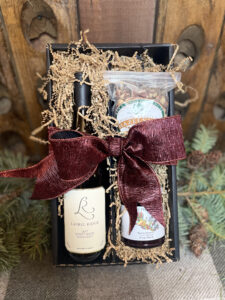
The Taste of Oregon pack is comprised of the Oregon Holy Trinity— Willamette Valley Pinot Noir, Hazelnuts, and Marionberry! The Taste of Oregon is the perfect gift to share with visiting friends and family or to take the taste of home with you when you travel.
Our 2017 Barrel Select Pinot Noir is carefully crafted by taking the best barrels of Pinot Noir from across the Willamette Valley. The marionberry jam is handmade in small batches from local and organic fruit at Alchemist’s Jam located in Mcminnville, Oregon. This pack is completed with roasted hazelnuts, lovingly harvested by family-operated Ken & June Hazelnuts located in St.Paul, Oregon. This pack embodies everything you love most about Oregon— small family businesses, locally grown and made products, and the charm of the Pacific Northwest.
Featuring a gift wrapped selection of:
- 2017 Barrel Select Pinot Noir
- Alchemist’s Marionberry Jam
- Ken & Junes Roasted & Salted Hazelnuts
Purchase Here!
Foodie Love
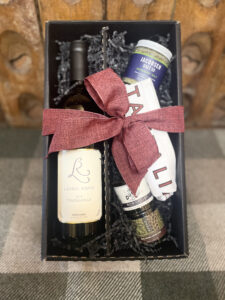
The Foodie was designed for the discerning home cook in your life. Elevate their ingredient game with locally sourced and handcrafted ingredients— all from Oregon. Cooking is best done with a glass of wine— specifically, our 2019 Tempranillo (a small-batch, club-exclusive offering.)
This pack features extra virgin olive oil and balsamic vinegar crafted at family-owned Durant, where they olive mill in the heart of Dundee, Oregon. Try it over burrata and bread— paired perfectly with our Spanish-style 2019 Tempranillo. Complete it with Jacobsen’s Rosemary Salt, hand harvested from the cold and pristine waters of the Oregon Coast. This pack also includes an adorable tea towel from featuring tons of Italian pasta shapes from Stoneground Kitchen.
Featuring a gift wrapped selection of:
- 2019 Tempranillo: Club Exclusive
- Durant EVOO + Balsamic Stack
- La Italia Pasta Shapes Tea Towel
- Jacobsen Rosemary Salt
Purchase Here!
Taste of Excellence
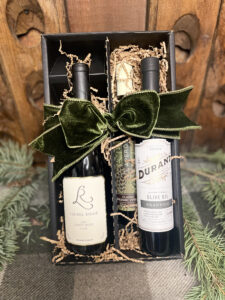
The Taste of Excellence gift pack is perfect for the holiday host that already has it all. Big, bold, and luxurious— everything your holiday season is meant to be.
This pack features extra virgin olive oil and Aperö balsamic vinegar crafted at Durant— paired perfectly together to be enjoyed for dipping bread or over salad. Enjoy it with our 2020 Pinot Noir Cuvée, a bold, lively and flavor-packed wine. Bold, unique, and charming just like the host in your life.
Featuring a gift wrapped selection of:
- 2020 Pinot Noir Cuvée
- Durant EVOO
- Aperö Balsamic Vinegar
These Oregon gifts are sure to delight the wine lovers in your life! These packs and more available for corporate gifting and shipping to most states!
Try this Cheesy Gordita Crunch Recipe with our 2019 Tempranillo
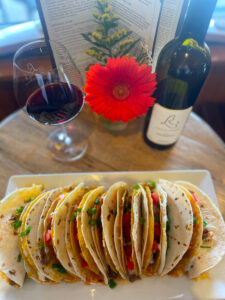
We find certain things we love can be more difficult to pair with wine and tacos are just that! Try our homemade cheesy gordita crunches— perfectly paired with our Spanish-style 2019 Tempranillo or our 2020 Barrel Select Pinot Noir.
Ingredients:
- 1lb ground beef (can substitute for preference, we recommended impossible meat for vegans!)
- 1 pack of taco seasoning (homemade recipe below, but store-bought works just as well!)
- Mexican blend shredded cheese
- 10 soft flour tortillas
- 10 hard shell tacos
For toppings:
- Lettuce, shredded
- Tomatoes, diced
- Mexican blend shredded cheese
- Taco sauce
Suggested additional toppings:
- Lime wedges
- Cilantro
- Avocado
For spicy ranch:
- Ranch dressing
- Tabasco sauce, to taste (can be substituted with hot sauce of preference)
- Ranch seasoning, to taste (optional)
Homemade taco seasoning:
- 2 tbsp chili powder
- 1 tbsp cumin
- 1 tbsp sea salt
- 1/2 tbsp black pepper
- 1 tbsp paprika
- 1 tsp oregano
- 1 tsp garlic powder
- 1/2 tsp onion powder
- 1/2 tsp cayenne pepper (if spicy desired)
Instructions:
- Preheat oven to 400°.
- Brown meat in a pan. Add taco seasoning and then cook for ten minutes, or until fully cooked.
- Set meat aside on low heat.
- Evenly spread tortillas on pan and add layer of Mexican cheese.
- Bake 3-5 minutes or until cheese is melted .
- Press hard taco shells into the center of each tortilla and press into one side, then fold the remaining cheesy side over.
- Bake for another two minutes to warm shell.
- Spoon meat into taco shell and assemble with spicy ranch, lettuce, tomatoes, and toppings of preference.
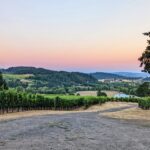
Vineyard Showcase: Menefee Vineyard
Working with a new vineyard has all of the excitement and anticipation of starting a new relationship. The first phase is full of wonder as you get to know one another, discovering the nuances and idiosyncrasies while exploring the chemistry between the site and vintner. By the time the barrel aging process is complete… that’s when the relationship starts to get serious. You have to decide if you’re in it for the long haul. Our relationship with Menefee Vineyard began in 2017 and quickly blossomed. By the spring of 2019, we were smitten.
Located in our home appellation of Yamhill-Carlton, Menefee Vineyard could not be more different than our own. Our estate, fondly referred to as Finn Hill, is on the easternmost edge of the Yamhill-Carlton AVA. We are directly on the boundary between the Yamhill-Carlton and Dundee Hills AVAs. Our site produces dark, brooding Pinot Noirs with robust tannin. They often look more like Syrah when they are young. Menefee Vineyard, on the other hand, is situated on the western edge of our AVA. Menefee is tucked far into the foothills of the coast range mountains and has a very different terroir than our own vineyard.
Terroir describes the distinct set of growing characteristics including soil, climate, wind and rain pattern, and other conditions that characterize a vineyard. Menefee specifically is rich in ancient, weathered basalt. This ancient volcanic soil usually allows for a little more water access and helps create a tannin structure that is softer and a wine that has more delicate characteristics. Despite this softer structure, we usually harvest this vineyard later in the season and on average lower in Brix— which means the natural acidity in the grapes is preserved. This site is what we consider the exact opposite of our own, as the wines usually showcase elegant red fruit, are more plush than angular, and feature refined, supple tannin. We usually find our Menefee Vineyard Pinot Noirs ready to be enjoyed at a far younger age than our Estate Pinot Noirs (although they both age splendidly).
On the wine making side, when we are tasting and blending our Pinot Noirs, we will only bottle a single-vineyard wine if we feel that it has achieved a Reserve-level of quality. For us, that means the wine showcases not only its terroir— but also its vintage. We are looking for exceptional and unique characteristics that define the wine, and we will only select the top four to ten barrels for these showcase bottlings. We know a vineyard is of exceptional quality when we are able to capture its distinctiveness year after year in the bottle.
We are on the cusp of releasing our third vintage from this single vineyard site— the 2019 Menefee. If you have visited one of our tasting rooms over the last three years, you will have undoubtedly seen or tasted our enchanting 2017 or 2018 Reserve Menefee Pinot Noirs. In honor of our third release from this vineyard, we have put together a limited edition vertical of all three vintages. Whether you open them together to explore the wonderful subtleties between the years, or save them to enjoy on their own special occasion, you will not be disappointed in furthering your connection to and understanding of this charming site.
Photography: Shane Farnor
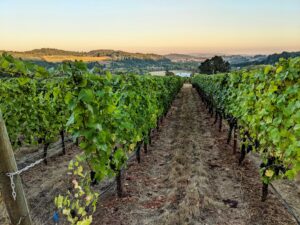
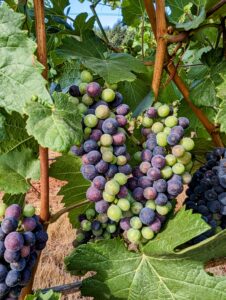
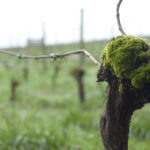
Another First for Laurel Ridge: Our 2022 Estate Chasselas Doré won a Silver at the Mondial du Chasselas in Switzerland
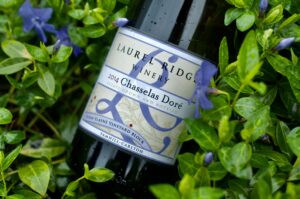
Normally Laurel Ridge does not enter wine competitions. We typically find ourselves too busy in the cellar making sure each wine is the best version of itself that it can be or in the tasting room showcasing our beautiful wines. We also make such small amounts of most things, we often don’t like to spare bottles for competitions as there is usually just enough of every bottle to be enjoyed by our wonderful club members and guests. But this spring something special happened.
Jason Lett at Eyrie Vineyards invited us to join him in submitting our Chasselas Doré to the worldwide Chasselas competition at Château d’Aigle in Switzerland. Jason has been calling us to participate for several years saying the Swiss are aware that we have Chasselas vines here in Oregon and they are eager to have us participate. So much so that they pay the entry fee into the competition and pay for the freight to get the wines to Switzerland (which costs more than a first class plane ticket!) This past spring, Jason had told Lucas that Eyrie has been competing for several years but had yet to receive a medal, but Jason seemed happy to participate in the Swiss festivities and we thought well, why not? We are one of only three vineyards in Oregon that grow this interesting and unusual Swiss varietal, the vineyards united by the deep roots we share as part of the re-founding of the Oregon wine industry- the connection being Charles Coury (with whom David Teppola was invested in the late 1960’s) and David Lett.
Submitting our bottles of ’22 Estate Chasselas Doré to the Mondial competition had become a distant memory as we have been busy this year opening our Bend tasting room and ironically preparing our vineyard to receive some young Chasselas vines. Imagine our shock and delight when we were called in early July by a judge for the competition and found out we were awarded a silver medal. The jury— composed primarily of European judges, including representatives from various highly prestigious world wine organizations and federations— had decided our Chasselas Doré could hold its own. Amazing is not a strong enough word. It brought tears to our eyes. The ironies abound. This is our oldest vineyard. It is 43 years old. It was planted in the spring of 1980— the same year that David and Susan met. It is on its own roots. Our larger 50 acre vineyard on the hill, planted on own roots in 1981, succumbed to phylloxera in 2006. But our Chasselas soldiered on. It is old and phylloxerated now, producing almost nothing- only 40 cases in 2022. To have that tiny, struggling, 1 acre vineyard produce a silver medal in an international competition is astounding. We could not be prouder.
Read more about the competition from Michael Alberty on Oregonlive!
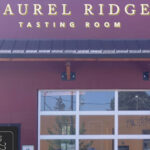
Our BEND Tasting Room is NOW OPEN!
We are thrilled to announce we will be bringing a bit of the Willamette Valley & our beautiful Oregon wines to Bend!
Our satellite tasting room in Bend, OR is now open at the Century Center in SW Bend! Visit us Thursdays-Sundays 12-7 this summer we can’t wait to see you on your next visit to Central Oregon.
40 SW Century Dr, Suite 120
Bend, OR 97702
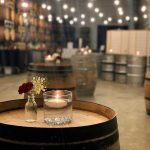
Sweetheart Dinner, Saturday February 11th
Join us for our 5 course Sweethearts Food & Wine Dinner on February 11th, 2023.
Details: Join us for a cozy and romantic evening in the Laurel Ridge Estate Barrel Room for our Sweetheart Dinner. This 5 course, semi-formal food & wine dinner is set to be delicious and indulgent. Doors open promptly at 6:15 for this wonderful event. We kindly ask that you don’t arrive early.
*Because these courses have been perfected to showcase our wines, we are unable to accommodate food allergies or preferences.
**Tickets are non-refundable. In the event that you purchased tickets and are unable to attend, consider gifting your tickets to family or friends.
Visit our Special Event Tickets page for tickets.
Overcoming Adversity: A Conversation with Susan Teppola
Recently, I had the opportunity to sit down with our owner, Susan Teppola, to discuss the history of our winery and her role in shaping the past and future of our farm over the last 4 decades. In 2006, Laurel Ridge lost both its original estate vineyard, and its founder, David. Either one of these tragedies on their own would have been enough to cause irreparable damage. No one – including David, before his passing – expected Laurel Ridge to continue on.
Susan’s decision to keep the farm that she and David had invested their lives in flew in the face of conventional wisdom. This decision tells the story of incredible love, sacrifice, and overcoming adversity despite all the odds…and that is where my interview with her begins.
Q:
2006 was the year that we lost both the original vineyard, and David, correct?
In 2006, we lost both our original estate vineyard, as well as my husband. Well, the phylloxera and David’s passing were two totally separate tragedies. They culminated in the same year, but they were totally separate.
Q:
Can we start with the phylloxera? When did that begin?
We were diagnosed with phylloxera in the mid-1990’s. We were the 7th vineyard in Oregon to be recognized by the Department of Agriculture in Oregon State University as being stricken with phylloxera.
I remember when David told me – he called me at work, and I think I almost fell out of my chair. I was just stunned, and heartbroken, really, because we had nurtured those vines from infancy – some of them were replanted twice, in 1980 and 1981. We hand watered those vines through the very, very hot summer of 1981 – I literally had a watering can. In case you were wondering, 40 acres of grapes was a lot to water by hand.
It was just terrible. The vineyard was really only 13 or 14 years old when it was diagnosed, so only a third of the way through its lifetime. It’s like having a kid in your 30’s get cancer – they’re only a third of the way through, and there they are.
Q:
What was David’s approach to the phylloxera?
Well, David really had two approaches – at first he thought, if it dies, that’s okay, because it’s one or two degrees off a true south axis. But he transitioned out of that pretty quickly. David began researching, and there are things that you can do to the vineyard to help it limp along. The path he chose was initially tried in Australia. Essentially, phylloxera strangles the plant and interferes with its ability to bring water up from the root. By fertilizing and supporting the plant in certain ways, you can lengthen its lifetime despite the phylloxera. Essentially, you’re delaying it’s death That worked for a while – you could still see concentric circles of phylloxera killing the vines, but some of the others looked incredibly healthy. The last harvest was 2006, which was far longer than most people would have thought our vineyard would have survived.
Q:
What was that final harvest like, in 2006?
It was tiny – it was a little bit of Pinot Noir which was only one of four different varietals we were growing. There was so little of it that we bought a clear shower curtain, put the de-stemmer over the barrel, and used the shower curtain to contain the grapes. We only ended up with one barrel of 2006 Estate Pinot Noir and it was fermented in the same barrel that it was aged in. I honestly can’t remember when we released it. So ultimately, the vineyard died the same year David died. But David managed the vineyard for more than 10 years after it was originally diagnosed, so they were really two separate struggles.
Q:
Shifting our attention to the other tragedy…can you tell me about when David got sick?
David got sick just after we moved to the farm in 2000. He was initially diagnosed with colon cancer in 2001, but that was inaccurate. He had adenocarcinoma that settled in his colon. He did chemotherapy and surgeries for some time, from 2001 to 2003, then he was healthy from 2003 to 2005. His cancer returned with a vengeance in March of 2005. There was more chemotherapy, and more surgery, but he passed on January 7, 2006.
Q:
Was David making wine during this time period?
Yes, David had made wine in the fall of 2005. Although our estate yield had dropped dramatically, he still had chosen to purchase grapes from his usual growers.
Q:
What did David want you to do with the farm? Had you two discussed what you were going to do with the vineyard in the event that he passed?
I knew that he was very concerned about the viability of both the vineyard and winery when he got his terminal diagnosis. I remember he said to me in the hospital, “Now this may be too hard for you…but I need you to bulk off all of the 2005 vintage – sell it all. I’ve already got one sale organized for you (David had sold some barreled Pinot Noir to Willamette Valley Vineyards). Then, sell the rest of the inventory – labeled bottles and all. And then, sell the equipment. And then when that has been sold off, you’ll sell the farm.
And, I said, “Okay, David, then that’s what we’ll do.”
Q:
Well, we both know that isn’t what you did – here we are 15 years later. Did you ever have any intention of selling the farm?
No. Never. From the moment he said, ‘it’s going to be too hard for you,’ and told me to sell the farm, I resolved that I was not going to be doing that. I would not do that.
The night before he passed away, David gave me the keys to the winery, and he said it’s just too late for me to show you how to do exactly everything, but here they are.
Q:
What did you do immediately after he passed?
I honestly can’t remember the first thing I did. I had the keys, but I just sat at his desk for a long time. I finally thought, well, you probably have to answer the phone. And I’m pretty sure that you have to pick up the mail. And I just went from there.
Q:
Did you have wines in barrel and fermenting?
Oh yes, but we had no winemaker. So there were a few custom clients that were in the building, and they helped me – but those early days are such a blur. I can just hardly remember. I worked primarily with consulting winemakers who were utilizing our facility until I got my feet under me.
Q:
What did that period of time from 2006 to 2015 look like? How did your relationship with the vineyard change over those 9 years?
Well, in the very beginning I was so overwhelmed I couldn’t think more than 15 minutes ahead. I literally started with, “Maybe I could make it through the next 15 minutes.” And then I’d think, ‘Well maybe we could make it through the next day, and then maybe we could make it through the weekend. All that really changed was that the window of time in which I was hopeful we could make it lengthened, and just kept lengthening.”
The good thing was, I had always worked in the tasting room on the weekends, so I knew how to do that. After David’s death, the out pouring of love was unbelievable. We had people who were friends of David’s who filled in and came every weekend for 2 years, to either help us with the facility or help us with sales. These friends didn’t accept any money – maybe a bottle of wine, but really they wouldn’t take anything.
Then we moved on to having part timers. We had a huge sign up sheet, and people would sign up to work this Saturday, or this weekend, etc. Pretty soon our roster was full of people who would like to work once a month or twice a month. It was mostly people who had full time jobs and wanted to do something extra on the sides. We never had help during the day, except during the summer. Sometimes if it got really busy, I used to add help during the weekdays. There was a bell that would ring, and one of the guys in the back would come out to help customers.
Q:
So you really didn’t have a consistent staff? Were you working in the tasting room everyday?
Yes. I always tried to get home from my other job (with the State of Oregon) as soon as possible so that I could relieve the production guys, because they had to work the tasting room as well as the cellar until I got there. As soon as I got home, I’d work the tasting room.
Q:
It sounds like during the beginning of this time period, you were just trying to survive.
Absolutely. But as time went on, while we were trying to survive, we decided we should really help others do the same thing. I just figured, they’re struggling, I’m struggling, we’re all just struggling. I figured we may as well just struggle together. I took on a social service agency function – this is something that we still do to this day. We’ve been the first job for a lot of teenagers, and for a lot of kids who needed it. I’m very proud of that.
Their parents have probably told them the same rules, but who listens to their parents? It’s important for kids to go to a job where their employer re-enforces what their parents have told them – that it’s important to have an employer who tells them the same things. Get up on time, get dressed, go to work and be there on time and ready to work.
This all started with a kid named Kyle, who was a Yamhill-Carlton High School student. I think he was a Junior. I came home one day from my other job in a little bit of a rush. It must have been 3:30 or 4:00, after school.
I walked in and there was this – well, know how teenagers – especially boys – tend to walk hunched over? They just don’t stand up straight. And he had all the blemishes that showed his adolescence, he was shy as could be. So there was this teenager, and he starts telling me his story his mother had been taken to jail, he had a little sister who was much younger, and they were being cared for by an aunt. Dad wasn’t in the picture.
He told me this whole story and then said, “Is there something you can do for me?” And so I said, “Yeah, if you come back on Saturday, I’ll give you a job.” And sure enough, there he was on Saturday.
One of the guests in the tasting room overheard the conversation said, the way you handled that was just incredible. And I said, “Well, we can’t do hand-outs, but we can do hand-up’s.” But I don’t think Kyle was looking for a hand out, the way he said it. He shared his story, and just asked what I could do for him. So I did what I could.
Q:
How did Kyle hear about the winery?
No idea. I don’t know. I still don’t. I also didn’t have a job for him, to tell you the truth. I thought he might just mow my lawn. But it ended up, I walked out to the boys out back and I said, “We have a new crew member!” And they said, “Well what are we supposed to do with him?” And I said, “I don’t know, but here he is!” And it was great. It ended up being one of the best, most productive business decisions, for both of us.
Q:
So there were quite a few years you were on your own, mostly – working full time as a Judge, and then working the tasting room in the evenings and weekends. What changed that made you decide to double down and complete such a large replanting in 2015?
Well in 2015 – by that time – Kira (Susan’s eldest daughter) had expressed an interest in coming back to the business. We just decided to double down. David and I never expected our kids to come back to the business. But obviously it would be there from them if they did that. And really, the only way to do that is to be an estate winery once more. The winery was bankable at that point. We had a really great relationship with the agricultural development of Bank of the West. They gave us a loan to plant 16 acres of vineyard – and I managed to squeeze 24 acres out of the loan, I made every penny squeal as our banker pointed out.
Q:
What are your plans for the future of the vineyard? Will you be doing more replanting?
Oh yes. We have a patch of Pinot Noir that we need to fill out. But after that, the next thing I’d like to do is plant Sauvignon Blanc, along with some other small blocks of white wines – Pinot Blanc for sure. From there, we need to add some more reds to our estate, but I’m not sure what that would look like.
The interesting part about being in the wine industry right now is that we do have climate change – so you really have to look at the science of it. It’s more than a question of what you want to plan, but what will succeed with global warming. There’s no sense in planting things that aren’t likely to succeed. So when we think about the future and what we may plant next, we have to think about varietals will be best for our soil, aspect, and elevation over the next 30 years. It’s not just a matter anymore of what you like – it’s a matter of what will work. But it’s very exciting, nonetheless.
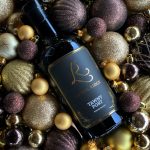
Re-Introducing… Laurel Ridge’s Tawny Port!
Every holiday season needs a little extra sparkle – especially this year, which has presented a unique set of challenges. Here at the vineyard, we thought we would help make your holiday season bright with a very special re-introduction…our Tawny Port.
 Port is a wine that our vineyard has historic reputation for producing, and may be one of our most anticipated releases within the last decade. Our founder David Teppola began crafting Ports in 1998. He began with a Ruby Port, followed by a Tawny Port released in 1999. David had his own special, proprietary process that he utilized. Crafting a Tawny Port is a delicate balancing act requiring the wine’s elements of acid, alcohol, and sugar to be in perfect measure. Knowing this, he felt very strongly that crafting a Port that would meet his standards for character and quality required exacting attention to detail and the highest caliber product every step of the way. David’s process reflected this commitment to excellence, from the brix (or sugar) content of the original fruit being used, to the quality of the still Pinot Noir he sent to be distilled into brandy, to his choice of Clear Creek Distillery to produce our brandy
Port is a wine that our vineyard has historic reputation for producing, and may be one of our most anticipated releases within the last decade. Our founder David Teppola began crafting Ports in 1998. He began with a Ruby Port, followed by a Tawny Port released in 1999. David had his own special, proprietary process that he utilized. Crafting a Tawny Port is a delicate balancing act requiring the wine’s elements of acid, alcohol, and sugar to be in perfect measure. Knowing this, he felt very strongly that crafting a Port that would meet his standards for character and quality required exacting attention to detail and the highest caliber product every step of the way. David’s process reflected this commitment to excellence, from the brix (or sugar) content of the original fruit being used, to the quality of the still Pinot Noir he sent to be distilled into brandy, to his choice of Clear Creek Distillery to produce our brandy
David continued to make Port, ultimately winning two gold medals at the Astoria Seafood and Wine Festival in 2004 with a Cabernet Franc Ruby Port which was one of our most popular to date. That vintage was followed by another enormously popular Cabernet Sauvignon Port in 2008.
This year’s release of Tawny Port is half Cabernet Sauvignon and half Cabernet Franc, combining the two incredibly followed 2004 and 2008 vintages into one beautifully crafted Port. The barrels at the time of this bottling had been aged for 14 to 16 years.
Our Tawny Port is immediately eye catching, with a beautiful, shimmering copper color. The warm, enveloping aroma surrounds you with brown sugar, vanilla, and hazelnut, making us think of creme brûlée. Each sip of the port brings warming and nostalgic flavors such as caramelized figs, gingerbread, and peanut brittle, balanced with the slightest musky notes of tobacco leaf. This will be the perfect wine to end a holiday meal, and add some cheer as loved ones open gifts.

With a wine as decadent and scrumptious as this, you won’t have to look too hard to find the perfect accompaniment. If you’ve got a sweet tooth, look no farther than lavish pairings such as chocolate, almond or walnut cakes, gingerbread or pecan pie. If your palate tends more towards a savory profile, then craft your holiday charcuterie plate up to feature rich, sumptuous cheeses such as Stilton, Gouda, or Bleu.
Contact the tasting room today to purchase our Tawny Port!
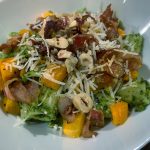
Sage & Walnut Pesto Pasta, with Acorn Squash
Recommended Wine Pairing: Laurel Ridge 2017 Chardonnay
Here in Oregon wine country, harvest season is a “round the clock” sort of affair. Fruit is arriving by the ton at all hours of the day and night, from all over the Willamette Valley and sometimes from as far away as Southern Oregon. A full night’s sleep is a luxury, and moment of rest are not guaranteed! When life is this busy, having delicious, filling meals is an absolute must – and let me tell you, “harvest meals” are a real thing here in the wine industry!

Meal prepping – or at least having a plan – is integral to these happy (but chaotic!) times, and is a chance to show our gratitude to our hardworking harvest crew. Our requirements for a Harvest meal is that they should be hearty, warm, seasonal, and absolutely delicious. This warm, cozy pasta has got all the components. It’s the time of dinner that invites you to sit down and relish every bite, whether you have 2 minutes, or 20. Best of all – you don’t have to be harvesting to enjoy it! It’s a great recipe for sharing, or to treat yourself to a little bit of magic on a weeknight.
There are more steps to this recipe than some we’ve posted – we recommend giving yourself a full 30 minutes to prepare this. If you’re feeling intimidated by the diced squash in this recipe, make sure to check out our instructions at the bottom for how to peel and cut a squash (I promise it isn’t nearly as hard as it looks!). Acorn squash is one of those items whose “bark” is far worse than its bite. But we promise – it is surprisingly easy to work with, and your hard work will be handsomely repaid with this delicious meal.
Ingredients:
1 acorn squash, cubed
2 tbsp olive oil
Kosher salt, to taste
Cracked black pepper, to taste
1 cup sage leaves
3 cups fresh basil
1/3 cup chopped walnuts
2 garlic cloves
1/4 cup Parmesan cheese (we love a sharp Parmesan Reggiano)
8 ounces sliced pancetta, crisped
Kosher salt, to taste
Black pepper, to taste
1 pound rigatoni or penne pasta
Directions:
1.Preheat oven to 425 degrees.
2.Toss cubed acorn squash in olive oil, kosher salt, and black pepper. Roast for 25 to 30 minutes, or until squash is fork tender.
3.Meanwhile, in food processor, combine basil and sage by pulsing. Once roughly chopped, add walnuts to basil and sage and run food processor continuously until well combined, then add garlic, parmesan, salt and pepper. Set pesto mixture aside.
4.Cook your pasta until al dente, according to instruction. While cooking pasta, lightly crisp pancetta in a steel pan over medium-high heat until the edges brown.
5.In bowl, combine pasta with 1/4 cup pasta water, pesto mixture, and stir until well combined.
6.Top with roasted acorn squash, pancetta, and parmesan.

On cutting the acorn squash…
First, cut your squash in half. Using a sharp knife, begin by pushing the tip of your blade down into the middle of the squash one to two inches, and then gently apply downwards pressure – like a lever. This way you can maintain an even cut, and you do not have to worry about any slippage. Once you have cut all the way through, spin the squash and cut from the other side! Now that you’ve halved the squash, scoop out all the pulp, guts, and seeds. Next, microwave the squash (the whole thing!) for 2-3 minutes. This increases the permeability of the skin, so that it can be more easily removed. Once you remove the squash from the microwave, give it a second to cool – then using a sharp blade (always!), gently cut away the skin. From here, you’re golden – dice away!
But as always, there are a couple of options! On nights that I don’t feel like doing a ton of cooking, the pre-cubed squash packages at Trader Joe’s are cost effective, and a total lifesaver.
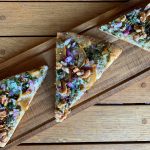
Caramelized Pear & Gorgonzola Pizza
Suggested wine pairing: Laurel Ridge 2019 Estate Pinot Gris, Yamhill-Carlton AVA, Willamette Valley
 This recipe was born out of sheer necessity. What I had planned for this particular Thursday evening was a delicious salad, featuring caramelized pears and gorgonzola. But what my heart desired was pizza. Slippery slope though this may be (because really, when don’t I want pizza?), I went ahead and mashed the two together.
This recipe was born out of sheer necessity. What I had planned for this particular Thursday evening was a delicious salad, featuring caramelized pears and gorgonzola. But what my heart desired was pizza. Slippery slope though this may be (because really, when don’t I want pizza?), I went ahead and mashed the two together.
Now, we are no strangers to unique food pairings here at Laurel Ridge, but this once seemed a little out there. I didn’t necessarily have high hopes. Pears? On pizza? Let me tell you, that first bite eroded any questions I had remaining. Delightfully sweet with the caramelized fruit, yet salty with the gorgonzola, yet crunchy with the walnuts…? I could go on. I would strongly advise crisping your pizza crust and embracing the crunch, which gives this pizza an additional flatbread like deliciousness. Plus, with vegetables (arugula) and fruit (caramelized pear)…this pizza is basically health food, right?!
Best of all, it pairs perfectly with our 2019 Estate Pinot Gris. Playing off the sweet honeysuckle and sweet orchard apple notes in the Gris, it makes for a match made in heaven.
Ingredients:
1 pizza crust, pre-made or par baked
3 tbsp olive oil
1 tbsp butter
2 pears, sliced finely
1 tbsp brown sugar
1/2 diced diced red onion
1/2 cup crumbled gorgonzola
1/3 cup mozzarella
1/3 cup walnuts
1 cup fresh arugula, washed, trimmed and roughly chopped (optional: tossed in 2 tbsp olive oil and the juice of one half lemon, salt and pepper to taste)
Directions:
1.Preheat oven to 425 degrees.
2.Combining butter and 1 tbsp of oil in the pan over high heat, add pear slices and stir until coated well. Cook for 3 – 5 minutes.
3.Add sugar to pears, tossing to coat and cooking for one minute further. Remove from heat.
4.Brush oil over pizza crust. Sprinkle mozzarella cheese over crust.
5.Arrange pears in one even layer over the pizza crust.
6.Sprinkle onion, then gorgonzola, then walnuts evenly over pizza.
7.Cook at 425 for 10 to 12 minutes, or until gorgonzola is melted and edges begin to turn brown.
8.Slice pizza, and top with fresh arugula as garnish.
And just like that, you’ve got an entirely unique (and entirely delicious) dinner! Creativity is the spice of life – so if you decide to make this recipe the own, more power to you! The possibilities are endless! And don’t forget – tag us in any recipes that you try at home! We love to see how you enjoy our wines at home.